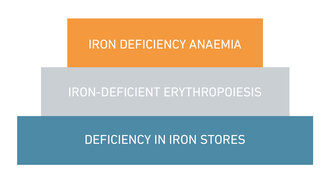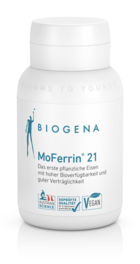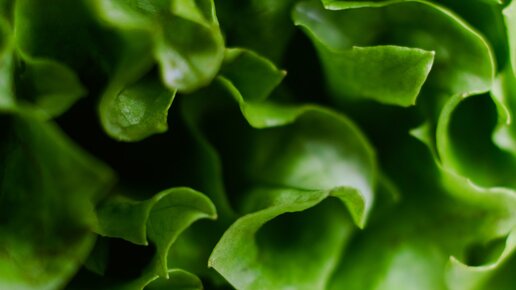Iron deficiency is the most common deficiency in the world. Approximately one third of the world’s population is affected. Due to the high relevance of the topic, in this article we will go into more detail about it, as well as about the causes, symptoms and consequences and examine what you can do if you are suffering from an iron deficiency.
Definition: What is iron deficiency?
Iron deficiency is defined as the complete consumption of the cellular storage iron required for metabolic and physiological functions. Iron deficiency can occur with and without anaemia. In short: With an iron deficiency, there is too little iron in the blood, which affects our organism in various ways. While blood formation is one of the last bodily functions that is affected by an iron deficiency due to its essential role, countless other iron-dependent bodily functions (= non-anaemic iron deficiency symptoms) suffer before this shows up in the blood. Accordingly, non-anaemic iron deficiency occurs much more frequently in Western countries than iron deficiency anaemia, which affects up to 20% of the population.
Causes: What causes iron deficiency?
Iron deficiency occurs when we supply our body with less iron than we consume or lose. This can be due to a low iron intake via diet, reduced iron absorption in the small intestine, increased iron requirements (e.g. pregnancy, exercise) or increased iron losses due to bleeding (e.g. severe menstrual bleeding, stomach ulcers). A loss of approx. 0.5 mg iron is anticipated for each 1 ml of blood.
Iron is often considered a female matter
Iron is considered to be THE female mineral. Which is no wonder, because menstruating women need more iron than men for about half their life – from puberty to menopause. The BIOGENA Good Health Study* showed that not every woman is successful in providing adequate supplies of the trace element – and in a dramatic way. For example, 37.7% of the women participating in the study were affected by iron deficiency (ferritin < 30 ng/ml). In comparison, only 5.8% of the men had an iron deficiency.

Iron deficiency in vegetarians and vegans – also a dietary issue
Live life with rosy cheeks and full of energy? This is fundamentally also possible without meat. However, it is often harder for plant eaters to fill up with enough iron. This is also confirmed by the Austrian BIOGENA Good Health Study*, which was able to show the greatest lack in supplies in the group of vegans. While 43.6% of omnivores and 25.6% of flexitarians were optimally supplied with iron, only 5.6% of vegetarians and 3.8% of vegans were in the optimal range. Meanwhile, more than half of the vegans (53.8%) and almost half of vegetarians (47.2%) demonstrated an iron deficiency (ferritin < 30 ng/ml).

Signs, symptoms & consequences: How can iron deficiency be recognised?
Energy level around 0? Pale complexion? Icy hands? This is probably the classic image of a person with iron deficiency. Iron deficiency, however, has many faces. Tiredness, declining performance and hair loss can occur even in the early stages. If the iron deficiency continues to progress (stage 2), countless other symptoms may occur. These may include dry skin, cracks at the corners of the mouth, susceptibility to infection, sensitivity to cold or difficulty concentrating. In the 3rd stage, the iron stores are so depleted that serious blood formation disorders become apparent. Not only does the number of red blood cells (= erythrocytes) decrease, but also their haemoglobin content. Such a highly advanced iron deficiency now manifests itself with classic symptoms of iron deficiency anaemia – including pale skin, headaches, dizziness, physical and mental loss of performance.

Symptoms at a glance:
| Neurological symptoms: • Tiredness and fatigue • Headaches • Declining capacity for thought • Forgetfulness • Concentration disorders • Sleep problems | Skin, hair & nails: • Brittle nails • Hair loss • Dry skin • Cracks at the side of the mouth • Cracked lips • Pale skin and mucous membranes |
| Mental factors: • Depressed mood • Restlessness • Tension • Attention deficit disorders | Musculoskeletal system: • Muscle weakness • Rapid fatigue • Reduced performance • Restless legs syndrome |
| Nutrition: • Loss of appetite | Cardiovascular system and lungs: • Anaemia (iron deficiency anaemia) • Palpitations • Dizziness • Shortness of breath • Feeling of cold • Exhaustion |
| Immune defence: • Increased susceptibility to infection |
Determine iron deficiency
Those who suspect that they are suffering from an iron deficiency can find out by having a laboratory diagnostic blood test. But what do you need to consider here?
Iron values: When do we talk about iron deficiency?
Haemoglobin levels are often measured if iron deficiency is suspected. This provides information on how much iron is in the blood, but does not indicate how it is generally supplied by the body's iron stores. Ferritin levels, transferrin levels and transferrin saturation should therefore also be determined for a precise indication of the iron status, which should ideally be within the normal range.
Normal values and deviations
Iron: Normal values and deviations. | |||
| Deficiency | Normal values | Excess | |
| Ferritin (in ng/ml) | < 30 | 30-300 | > 1000 |
| Transferrin (mg/dl) | > 400 | 200 – 400 | < 200 |
| Transferrin saturation (%) | < 16 | 16-45 | > 45 |
Rectify iron deficiency & top up iron storage: What can you do if you have an iron deficiency?
If you are suffering from an iron deficiency, you should get to the root of the matter with the help of a person with expertise. True to the motto “Know your enemy”, it is clearly advantageous to know whether the iron deficiency is based, for example, on malnutrition, heavy periods, reduced iron absorption – or even on several factors simultaneously. In addition to an iron-rich diet (see table "Vegan foods with iron content"), iron absorption can be increased using an iron preparation.
How long does it take for iron deficiency to resolve?
Treatment of iron deficiency or even iron deficiency anaemia usually takes a few weeks to months. Regular laboratory analysis is recommended in the case of long-term iron intake to ensure appropriate dosage.
How much iron per day in the case of iron deficiency?
How much iron is recommended per day in the case of iron deficiency varies from person to person. A healthcare professional can ascertain the current state of the affected person and match this with a reasonably dosed iron preparation.
If you have problems with high-dose iron salt preparations, you can also try low-dose plant-based special extracts (such as in MoFerrin® 21). Finally, if we are suffering from an iron shortage, our body is always able to increase the iron utilisation in the intestine. Studies now confirm that even gentle plant-based iron preparations can be highly effective in offering a targeted and tolerable alternative to the usual high-dose iron salts.
Supplementation for iron deficiency: Tablets, capsules, liquid iron, etc.
There are a number of different iron preparations on the market for combatting iron deficiency. From iron tablets to capsules, granules, various liquid forms and much more. While some people go for a great-tasting iron juice, others prefer iron packed in capsules – hygienic, practical and tasteless. Since nutritional supplements are usually taken over several weeks, care should always be taken to avoid unnecessary additives. Supplements that use special plant extracts (such as in MoFerrin® 21) as an iron source are also considered particularly gentle and well tolerated.
Iron deficiency during pregnancy & lactation
Pregnancy and lactation are two of the most demanding phases in life in which iron deficiency can develop more easily due to high physical requirements. The increased iron requirement during pregnancy is based on the fact that not only the expectant mother but also the growing child must be supplied with the essential trace element. In addition, the enlarged uterus and the cervix (placenta) are greedy for iron. An increased iron requirement continues during breastfeeding, since the losses sustained during pregnancy and birth still have to be compensated, but at the same time the child is also consuming iron via the breast milk. You can find out more about "Iron deficiency during pregnancy and breast-feeding" here.
Iron deficiency in children
Iron deficiency is no respecter of age. In strong growth phases in particular, iron is needed not only to maintain normal bodily functions, but also for increasing blood volume. Even though the child’s body is clamouring for iron, at the same time adequate iron intake can be difficult for the growing child – often due to an unbalanced diet due to the natural selectivity of children when eating, sometimes also due to food intolerance or an iron absorption disorder. Parents who suspect iron deficiency in their child should seek advice from healthcare professionals. Blood analysis may be used to detect an existing iron deficiency and to recommend a reasonably coordinated iron preparation.
Iron deficiency & menopause
Women who are close to menopause should also keep an eye on their iron levels. Hormonal changes can lead to severe monthly or interim bleeding, which can consume all their iron deposits. Once their periods stop (= menopause), the situation of the women affected becomes less demanding and their iron requirements become similar to those of men (= 10 mg iron daily).
Iron deficiency & sports
Especially in endurance and competitive sports, iron deficiency can quickly manifest itself in a lack of sporting success. Therefore, athletes who want to be at the forefront of their game should always keep an eye on their iron status. Because of physical stress and increased sweating, the body needs more iron – the sweatier the sport, the higher the losses, because with every litre of sweat the body loses 1.2 milligrams of iron. In addition, during high sporting activity, more of the iron-containing red blood pigment haemoglobin is produced, which is required for the formation of red blood cells (erythrocytes) and the muscle protein myoglobin.
The iron losses can become even greater, and can continue for a long time. Hard contact with the ground also causes the mechanical destruction of the red blood cells and additional iron is required for new cells to be formed.
Immune system & iron deficiency
A less well-known symptom of iron deficiency is that it increases your susceptibility to infection. Iron deficiency can thus be associated with the tissue loss of various organs of the immune system as well as with altered immune defences. Studies in developing countries show that iron deficiency in children impairs innate and acquired immunity and thus increases the risk of infection.
Vitamin B12 and iron deficiency
Iron and vitamin B12 perform similar tasks in our body. Both micronutrients play a role in our nervous system, in energy production and in blood formation. Accordingly, the symptoms of vitamin B12 deficiency are similar to those of iron deficiency.
What many people do not know is that a simultaneous iron and vitamin B12 deficiency can cause problems with diagnosis. An iron deficiency in the blood can mask a B12 deficiency - and vice versa. If a combined deficiency is suspected, more detailed laboratory tests should be conducted.
Conclusion: Iron deficiency is widespread worldwide and yet it is still misunderstood. People who have difficulty getting up in the morning and feel that they cannot get the most out of life either physically or mentally should probe more deeply into their iron levels and, if necessary, assist their body with additional iron. Because an increase in iron also means a more positive attitude to life!
About the BIOGENA Good Health Study
The BIOGENA Good Health Study, with 1377 participants, is Europe’s most comprehensive study on micronutrients, health and well-being. The aim of the large-scale study was to draw an up-to-date picture of the state of health and care of the Austrian population and to prove that a better micronutrient supply is rewarded with an increase in physical and mental well-being.
Frequently asked questions about iron
The combination of iron-rich foods – so-called “iron boosters” – can improve iron absorption into the body. Iron boosters are foods that contain vitamin C, vitamin A, fruit acids, lactic acids or sulphur-containing amino acids.
Symptoms that indicate iron deficiency (e.g. fatigue, concentration problems, loss of performance) may also occur in the course of other nutrient deficiencies or diseases. A laboratory diagnostic analysis is therefore indispensable to detect iron deficiency.
Typical symptoms of iron deficiency anaemia are fatigue, paleness, dizziness and a deterioration in physical and mental performance. Non-anaemic symptoms occur more frequently and earlier than symptoms of iron deficiency anaemia, such as skin and nail changes, hair loss, burning mouth syndrome or susceptibility to infection.
Iron deficiency is generally easily treatable. In addition to an iron-rich diet, iron preparations can replenish your iron stores.
Iron deficiency impairs the iron-dependent functions of the body. While blood formation is not impaired at the beginning, advanced "manifest" iron deficiency also causes serious disorders with blood formation.
Special herbal extracts containing natural iron (such as MoFerrin® 21) are considered particularly well tolerated.
References:
Fachgesellschaft für Ernährungstherapie und Prävention e.V. 2023. Eisen – Ernährungstherapeutische Aspekte. Stand Juni 2023. https://fet-ev.eu/eisen/ , zugegriffen 28.8.2023
Nielsen P. 2016. Diagnostik und Therapie von Eisenmangel mit und ohne Anämie. 2. Auflage. Bremen: UNI-MED Verlag AG; 2016.
Bergmann K. 2018. Anämie und Eisenmangel: Neue Norm- und Grenzwerte für Kinder und Jugendliche. Zeitschrift Pädiatrie. 2018; 5:25-32.
Brunner-Agten S, Meyer MK, Huber, AR. 2012. Eisenmangel, Gehirnentwicklung und kognitive Leistungsfähigkeit. Schweitzer Zeitschrift für Ernährungsmedizin. 2012; 3:28-35.
Hahn A, Ströhle A, Wolters M. Ernährung: Physiologische Grundlagen, Prävention, Therapie. 3. Auflage. Stuttgart: Wissenschaftliche Verlagsgesellschaft; 2016.
Biesalski, 2017. Taschenatlas der Ernährung. Georg Thieme Verlag KG.
Deutsche Gesellschaft für Ernährung e.V. (DGE). 2023. Referenzwerte: Eisen. https://www.dge.de/wissenschaft/referenzwerte/eisen/?L=0, zuletzt aufgerufen in
Hastka J et al. 2022. Eisenmangel und Eisenmangelanämie. Onkopedia Leitlinien. Stand: Juli 2022. https://www.onkopedia.com/de/onkopedia/guidelines/eisenmangel-und-eisenmangelanaemie/@@guideline/html/index.html, zugegriffen 29.8.2023
Yiannikourides A, Latunde-Dada G.O. 2019. A Short Review of Iron Metabolism and Pathophysiology of Iron Disorders. Medicines 2019, 6(3), 85.
Wallace D.F. 2016. The Regulation of Iron Absorption and Homeostasis. Clin Biochem Rev. 2016 May; 37(2): 51-62.
Lal A. 2019. Iron in Health and Disease: An Update. Indian J Pediatr. 2019 Sep 13.
Weiss G. 2016. Eisentherapie. Österreichische Ärztezeitung 13/14. 15. Juli 2016.
Lee E.C., Fragala M.S. et al. 2017. Biomarkers in Sports and Exercise: Tracking Health, Performance, and Recovery in Athletes. J Strength Cond Res. 2017 Oct; 31(10): 2920–2937.
Milman N et al. 2017. Iron status in pregnant women and women of reproductive age in Europe. Am J Clin Nutr. 2017 Dec;106(Suppl 6):1655S-1662S.
Breymann C., Auerbach M. 2017. Iron deficiency in gynecology and obstetrics: clinical implications and management. Hematology Am Soc Hematol Educ Program. 2017 Dec 8; 2017(1): 152–159.
Fernández-Gaxiola AC, De-Regil LM. 2019. Intermittent iron supplementation for reducing anaemia and its associated impairments in adolescent and adult menstruating women. Cochrane Database Syst Rev. 2019 Jan 31;1:CD009218.
Shoemaker ME,et al. 2019. High Prevalence of Poor Iron Status Among 8- to 16-Year-Old Youth Athletes: Interactions Among Biomarkers of Iron, Dietary Intakes, and Biological Maturity. Am Coll Nutr. 2019 Jul 24:1-8.
Low M.S. et al. 2016. Daily iron supplementation for improving anaemia, iron status and health in menstruating women. Cochrane Database Syst Rev. 2016 Apr 18;4:CD009747.
Merwe L.F., Eussen S.R. 2017. Iron status of young children in Europe. Am J Clin Nutr. 2017 Dec; 106(Suppl 6): 1663S–1671S.
Parisi F et al. 2017. Effects of different regimens of iron prophylaxis on maternal iron status and pregnancy outcome: a randomized control trial. J Matern Fetal Neonatal Med. 2017 Aug;30(15):1787-92.
Aporta RR, et al. 2016. Retrospective case reports of anemic pregnant women receiving intravenous ferric carboxymaltose: Experience from a tertiary hospital in Spain. Obstet Gynecol Int. 2016 Aug;5060252:1-5.
Joo EY et al. 2016. Iron deficiency anemia in infants and toddlers. Blood Res. 2016 Dec;51(4):268-73.
Wei S et al. 2019. Increased hepcidin expression in adipose tissue as a primary cause of obesity-related inhibition of iron absorption. J Biol Regul Homeost Agents. 2019 Jul-Aug;33(4):1135-1141.
Lam LF, Lawlis TR. 2017. Feeding the brain - The effects of micronutrient interventions on cognitive performance among school-aged children: A systematic review of randomized controlled trials. Clin Nutr. 2017 Aug;36(4):1007-1014.
Milman N, et al. 2014. Ferrous bisglycinate 25 mg iron is as effective as ferrous sulfate 50 mg iron in the prophylaxis of iron deficiency and anemia during pregnancy in a randomized trial. J Perinat Med. 2014 Mar;42(2):197-206. doi: 10.1515/jpm-2013-0153.
Bagna R et al. 2018. Efficacy of Supplementation with Iron Sulfate Compared to Iron Bisglycinate Chelate in Preterm Infants. Curr Pediatr Rev. 2018;14(2):123-129.
Fäth-Neubauer B., Viebahn I. 2012. Biogena Eisen-Interventionsstudie: Pflanzliches Eisen füllt Eisenspeicher. Biogena Naturprodukte GmbH.
Fäth-Neubauer B., Viebahn I. 2017. Pflanzliches Eisen ist in physiologischen Dosierungen effektiv. Biogena Naturprodukte GmbH.
Martin, M. 2009. Pflanzenbasiertes Eisen (MoFerrin®) im Vergleich zu einem herkömmlichen Eisenpräparat (Eisen-II-Gluconat mit Ascorbinsäure). GanzImmun Diagnostics AG.
Lönnerdal, B. 2009. Soybean ferritin: implications for iron status of vegetarians. Am J Clin Nutr. 89(5):1680S-1685S.
Theil, E.C. et al. 2012. Absorption of Iron from Ferritin is Independent of Heme Iron and Ferrous Salts in Women and Rat Intestinal Segments. Journal of Nutrition.











